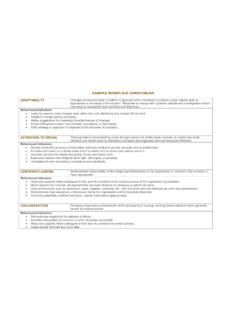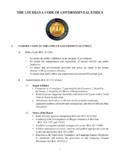Transcription of An Introduction to the Five-Factor Model and Its Applications
1 An Introduction to the Five-Factor Modeland Its ApplicationsRobert R. McCraeNational Institute on Aging, NIHO liver P. JohnUniversity of California at BerkeleyABSTRACT The Five-Factor Model of personality is a hierarchical organi-zation of personality traits in terms of five basic dimensions: Extraversion,Agreeableness, Conscientiousness, Neuroticism, and Openness to using both natural language adjectives and theoretically based per-sonality questionnaires supports the comprehensiveness of the Model and itsapplicability across observers and cultures. This article summarizes the historyof the Model and its supporting evidence; discusses conceptions of the natureof the factors ; and outlines an agenda for theorizing about the origins andoperation of the factors . We argue that the Model should prove useful both forindividual assessment and for the elucidation of a number of topics of interestto personality are the basic dimensions of personality, the most important waysin which individuals differ in their enduring emotional, interpersonal,experiential, attitudinal, and motivational styles?
2 Personality theoristshave offered hundreds of candidates, and for decades factor analystsattempted to bring order to the resulting confusion by factoring person-ality scales. Instead of resolving the issue, however, these studies onlycontributed another layer of controversy, most familiar in the compet-We are grateful to Michael Bond, Peter Borkenau, David Buss, Paul Costa, DonaldFiske, Lew Goldberg, Robert Hogan, and Warren Norman for comments on this manu-script, and to Stephen G. West and the associate editors of this journal for their adviceand assistance on this special issue. Correspondence may be addressed to Robert , Personality, Stress, and Coping Section. Gerontology Research Center, 4940 Eastern Avenue, Baltimore, MD article lies in the public domain because it was written for and funded by thefederal McCrae and Johning systems of Guilford, Cattell, and H.
3 J. Eysenck. So when Tupesand Christal (1961; reprinted in this issue) found five recurrent factorsin analyses of personality ratings in eight different samples, they wereunderstandably surprised:In many ways it seems remarkable that such stability should be foundin an area which to date has granted anything but consistent the consistency has always been there, but it has beenhidden by inconsistency of factorial techniques and philosophies, thelack of replication using identical variables, and disagreement amonganalysts as to factor titles, (p. 12)Despite their work and the more widely read replication of Norman(1963) the importance of these five factors remained hidden frommost personality psychologists throughout the 1960s and 1970s. In the1980s, however, researchers from many different traditions were led toconclude that these factors were fundamental dimensions of personality,found in self-reports and ratings, in natural languages and theoreticallybased questionnaires, in children, college students, and older adults, inmen and women, and in English, Dutch, German, and Japanese samples(John, 1990a).
4 All five factors were shown to have convergent anddiscriminant validity across instruments and observers, and to endureacross decades in adults (McCrae & Costa, 1990). As a brief introduc-tion to their nature. Table 1 lists definers of the positive pole of each ofthese new consensus has grown rapidly. Two or three years ago, aspecial issue on the topic would doubtless have been filled with articlesoffering evidence for or against the Model itself ( , Borkenau &Ostendorf, 1989; Noller, Law, & Comrey, 1987; Waller & Ben-Porath,1987; Zuckerman, Kuhlman, & Camac, 1988). We will review some ofthat evidence here; it is also treated elsewhere (Digman, 1990; Gold-berg, 1990; John, 1990a; Wiggins & Trapnell, in press). Today webelieve it is more fruitful to adopt the working hypothesis that thefive-factor Model (FFM) of personality is essentially correct in its rep-resentation of the structure of traits' and to proceed to its implicationsfor personality theory and its Applications throughout psychology.
5 Thishas been our guiding principle behind this special In this article we use phrases like "structure of traits'" and "dimensions of per-sonality" to refer to the patterns of covariation of traits across individuals, not to theorganization of attributes within the individual (cf. John. 1990a. p. 96). Introduction 177If this hypothesis is correct if we have truly discovered the basicdimensions of personality it marks a turning point for personality psy-chology. Instead ofthe interminable disputes among competing systemsthat so long paralyzed the field, we could see cooperative research andcumulative findings. Instead of the redundancy that results from mea-suring the same construct under a dozen different names, we could seean efficient integration of the literature across many instruments.
6 Andinstead ofthe lost insights that a haphazard selection of personality vari-ables is likely to produce, we could see a complete and systematic pur-suit of personality correlates. The FFM could provide a common lan-guage for psychologists from different traditions, a basic phenomenonfor personality theorists to explain, a natural framework for organizingresearch, and a guide to the comprehensive assessment of individualsthat should be of value to educational, industrial/organizational, andclinical its most ardent defenders do not claim that the FFM is the lastword in the description of personality. There are disputes among five -factorists about the best interpretation of the factors ; there are certainlyimportant distinctions to be made at the level of the more moleculartraits that define the factors ; and it is possible that there are other basicdimensions of personality.
7 But some version of these five dimensions isat least necessary for an adequate description of individual differences,and if all personality researchers compare their preferred system to thisframework, it should soon become clear whether and in what ways themodel is and Identifying the FactorsThe consensus that five -factorists see among themselves may be puz-zling to outsiders because the "disagreement among analysts as to fac-tor titles" that Tupes and Christal noted still plagues the field (John,1990b). Factor names reflect historical accidents, conceptual positions,and the entrenchment that comes from a published body of literatureand from published instruments. There are two prominent systems fornaming the factors , one derived from the lexical tradition and one fromthe questionnaire writers take Norman's (1963) annunciation of an "adequatetaxonomy of personality attributes" derived from Cattell's reduction ofnatural language trait terms as the formal beginning of the FFM, andthe factor numbers and names Norman chose I: Extraversion or Sur-CJC/500 OJc03,0 OJcs.
8 1 i(Ug) E^ I , IOJ E O -SC li c/: 2^ .s 5 ^QoCJPHE liao3x:oEOJXli a>S . ;00"2 "5a, 'uo-C^ OJ 'COJc OJ^ ." -^00 li , . o -=..-l.^ ^ 11/ ^" . '^ HJOS UH aa a Z cn:^< ^ "ojS c g >..2i2 -a 2 S"^ ? - JU ^ ^ -^X^ Cj U C^< Z oa IOJ !/l00 3c cUJ UJ00 OJO F2> 2o <"u. O^ aliC N _ JJIEIIH UJ O exr2 x:yi 00C 32 asliX)oUHZoUJcliOJ60< S ^e :5 I < . SccH m00c3 'I*O OH <U>TzE3liccOJexo1o -s oc '^ 'i E u s -a - a, II 1 I 1 IIu cd o xi -^i. "SC/5 QQ U tL< > >oCJc35 BII3II>. li a E SOJ CS^ E2O^ o1 iC/5 o 5-1 cd-i03 OEo^ cE BCJ TOcd^ a UJaOJ ONXIO180 McCrae and Johngency; II: Agreeableness; III: Conscientiousness; IV: Emotional Sta-bility; and V: Culture are often used.
9 Peabody and Goldberg (1989)have noted that the order in which these factors emerged roughly par-allels their representation among English language trait terms in thedictionary: Many more words can be found to describe aspects of Fac-tors I through III than of factors IV and V. The factor numbers, I to V,are thus meaningful designations. Roman numerals also have the ad-vantage of being theoretically neutral; they seem to stand above the frayof disputed factor second tradition that led to the modern FFM comes from theanalysis of questionnaires, and particularly from the work of H. , who identified Extraversion (E) and Neuroticism (N) as majorcomponents of psychological tests. (It was Wiggins, 1968, who dubbedthese the "Big Two," setting the stage for Goldberg's 1981 designa-tion of the FFM as the "Big five .)
10 ") Costa and McCrae (1980) addeda dimension they called Openness to Experience (O), and later (1985,1989) created scales to measure Agreeableness (A) and Conscientious-ness (C). A number of publications ( , Borkenau & Ostendorf, 1990;Funder & Colvin, 1988; Tellegen & Waller, in press; Wiggins & Pin-cus, 1989; Zuckerman, Bernieri, Koestner, & Rosenthal, 1989) haveadopted this nomenclature. Note that N corresponds to low EmotionalStability, IV, and O is a variant of Norman's Factor the advantage ofthe Norman numbers is their theoretical neutrality,the disadvantage is their low mnemonic value. Initials, originally popu-larized by H. J. Eysenck, are easier to interpret, and they may be lesstheoretically laden than full names. To those for whom Neuroticismconnotes psychiatric disorder, negative affectivity (Watson & Clark,1984) or simply nervousness may seem more apt; all can be charac-terized by N.







